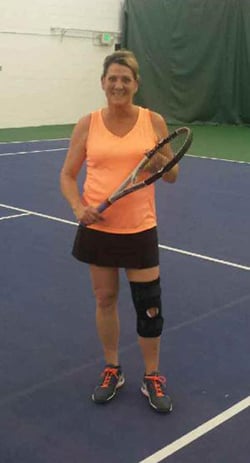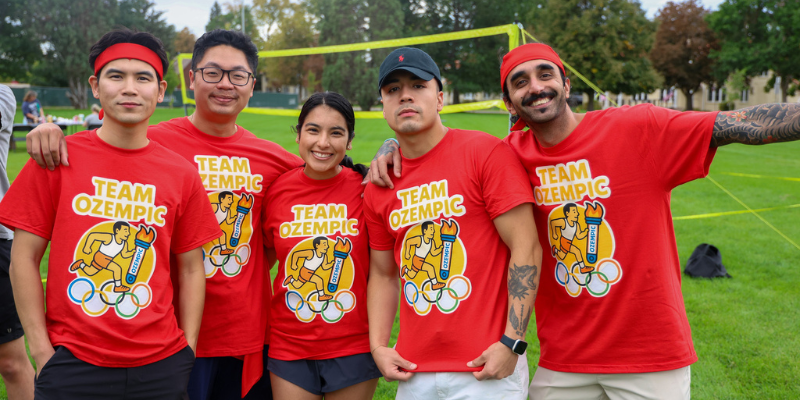We all need someone like Patricia Meyer in our lives: someone to keep us pointed in the right direction; someone to consider all the details and make things happen; someone to keep track of all the things we forget; and someone to offer a smile and a friendly greeting.
 The students and her colleagues at the CU Skaggs School of Pharmacy and Pharmaceutical Sciences at the Anschutz Medical Campus are so lucky. Meyer is a program assistant for experiential programs and came to the university five and a half years ago on the recommendation of her tennis doubles partner. She had just closed her business and was spending a lot of time on the courts when the friend recommended she consider a job at the School of Pharmacy.
The students and her colleagues at the CU Skaggs School of Pharmacy and Pharmaceutical Sciences at the Anschutz Medical Campus are so lucky. Meyer is a program assistant for experiential programs and came to the university five and a half years ago on the recommendation of her tennis doubles partner. She had just closed her business and was spending a lot of time on the courts when the friend recommended she consider a job at the School of Pharmacy.
Her duties there are numerous, but most involve helping students navigate sometimes complex administrative requirements both on campus and in the field. She also coordinates two student outreach programs that are in partnership with several elementary schools in the area: the Pharmacist for a Day program and an annual service learning project. Meyer also coordinates CPR training at the school for students, faculty and staff. A certification is required for all students and most faculty members at the school.
Away from the office, she spends as much time as she can outdoors, playing tennis, swimming, hiking and playing golf.
1. What is the Pharmacist for a Day program and how are you involved in it?
I took over the program about four years ago. Students from fourth-grade classrooms in four elementary schools – Montview, Park Lane, Vaughn and Laredo elementary schools – take a field trip to our campus during the first week of January when our pharmacy students are on break. So the pharmacy students volunteer to present this program, which includes two sessions a day for four days. My role is to coordinate the program.
During the first session, the students learn about the differences between candy and medicine. The other half of the class teaches compounding and why it is important. The kids get to use a mortar and pestle and create a lotion-based substance, which is what compounding really is. At the end of the session, the elementary students go through what we call a “white coat ceremony,” which is what our first-year pharmacy students go through at the end of orientation week. The fourth-graders are presented with a certificate of achievement and each class member signs a poster. This isn’t a high-intensity program where their eyes are bugging out; it’s scaled way down and is really fun.
2. Pharmacy students also participate in a service learning project, which you also coordinate. What does the program accomplish?
The program is conducted by our first-year pharmacy students and we partner with the same four elementary schools near the Aurora campus as we do for the Pharmacist for a Day program. The pharmacy students teach nutrition-based lessons to the elementary students. The content of the classes includes eating the right foods, how to stay healthy and understanding food allergies. I coordinate the project with the schools and make sure our students have everything they need to teach the lessons.
The pharmacy students have the opportunity to take the lesson content and build off of it to make the presentations their own, whether they prepare power points or a skit, etc.
3. You sound very passionate about your job and helping others. Why is it important to you to do that?
I think that if we expect our students to give back to the community then it’s important that the staff and faculty be role models and also give back to the community. So I do as much as I can, including volunteering at 9Health Fairs and those types of things. I think a lot of my involvement is with the four elementary schools, too, and not just my CU job duties, but in my own personal relationships with the teachers, including sitting down with them and understanding their diverse populations and what we can do to better the program we have. That’s really where I think I enjoy giving back the most.
4. How did you become interested in tennis and, as a coach, what “lesson” do you teach your students?
I’ve been playing well over 30 years and got involved with the game originally because I wanted my children at a young age to understand how the game is something they could enjoy for a lifetime. They played team sports when they were small, but didn’t have much interest in tennis until high school. They both played four years in high school and both played in college. I was able to work out with them in both high school and college. They are both tennis teaching professionals here in Colorado.
I find tennis very rewarding, and still play at a competitive level.
When I coached the junior varsity team, the main thing I wanted the boys on the team to understand is that tennis is a sport they can take with them, and you get out of it what you put into it. I encouraged them to put into it everything they could. We had a lot of fun and they walked away with a greater understanding of the game.
5. What do you consider a favorite part of your job?
The students – and my interactions with them – are very rewarding. Most of the students are right out of their undergraduate programs, and having someone with a sympathetic ear available to them is important. It’s also about having someone to hold them accountable. Everyone likes to know they are appreciated and I think the School of Pharmacy does a really great job of recognizing their employees, and the students appreciate the support we give them.
Graduation is always a rewarding time. After graduation last year, the wife of one of the students I interacted with came up to me and gave me a big hug and said, “I appreciate all that you have done for my husband. We are so grateful.” Knowing I had made a difference is rewarding.
Story first appeared in CU Connections, June 16, 2016.


